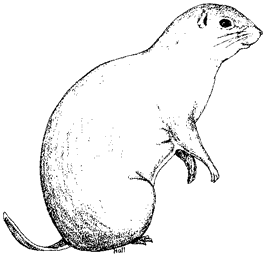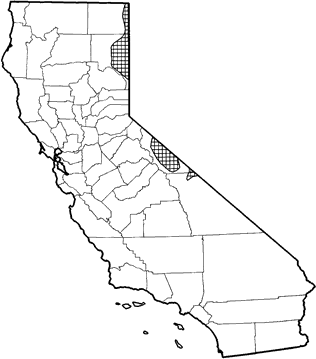
Townsend's Ground Squirrel
Distribution, Abundance, and Seasonality
Townsend's ground squirrel occurs in arid habitats along the Nevada border in Modoc, Lassen, Mono, and Inyo cos. Common at times in sagebrush, low sagebrush, and alkali scrub. Less common in bitterbrush, and least common in pinyon-juniper habitat. May invade croplands of alfalfa and grain in winter and spring.

Range Map
Specific Habitat Requirements
Feeding: Mainly herbivorous; eats green leaves, plant stems, flowers, roots, bulbs, seeds, unripe grain, insects, and carrion, and frequently is cannibalistic. It forages on the ground surface and digs for food (Hall 1946). In Washington, bluegrass, forbs, and phlox were eaten, while bluebunch wheatgrass, fescue, and lomatium were avoided. No difference in diet with sex or age was observed, and diets were similar in grazed and ungrazed habitats (Rogers and Gano 1980, Rickart 1987).
Cover: Uses the cover of shrubs to avoid predators and heat. Digs escape burrows at the base of shrubs. Burrows may extend from cover to feeding areas (Whitaker 1980).
Reproduction: A nest of grass, sagebrush, and other materials (Hall 1946) is located in the burrow system, which may be up to 15 m (50 ft) long and 1.8 m (6 ft) deep.
Water: May not require free water for drinking. Obtains water from green plants, aestivating when plants are dry (Shaw 1921).
Pattern: Prefers sandy, friable soils in shrub habitats, and rocky areas in pinyon-juniper woodlands. May invade alfalfa or grain fields, causing crop damage.
Species Life History
Activity Patterns: Active in the spring and early summer, from January to June or July. Summer aestivation begins when plants are no longer green. Townsend's ground squirrel is diurnal, with activity peaks in the morning and late afternoon. Strong winds decrease activity.
Seasonal Movements / Migration: None.
Home Range: Density may reach 76/ha (30/ac), and may vary cyclically.
Territory: Probably territorial near home burrow. These squirrels live in large colonies.
Reproduction: Mating occurs soon after activity begins (January through March). Gestation period is 23 or more, days; the young are born in February through April. Average litter sizes reported include 9 (range 4-16) (Hall 1946) and 4.8 (Svihla 1939). One litter is produced per year. The young are weaned in 35 days and reproduce as yearlings.
Niche: This diurnal herbivore is preyed upon by badgers, weasels, and hawks (Whitaker 1980). It occasionally is subject to severe die-offs, perhaps from epizootic disease (Hall 1946). This squirrel is excluded from more humid areas by Belding's ground squirrel. Townsend's ground squirrel is a possible vector for plague.
Sources & References
California Department of Fish and Game, 1999.
California's Wildlife, Sacramento, CA.
Written by: V. Johnson, reviewed by: H. Shellhammer, edited by: J. Harris
Alcorn, J. R. 1940. Life history notes on the Piute ground squirrel. J. Mammal. 21:160-170. Bailey, V. 1936. The mammals and life zones of Oregon. U.S. Dep. Agric., North Am. Fauna No. 55. 416pp. Dalquest, W. W. 1948. Mammals of Washington. Univ. Kans. Publ., Mus. Nat. Hist. 2:1-444. Hall, E. R. 1946. Mammals of Nevada. Univ. California Press, Berkeley. 710pp. Rickart, E. A. 1987. Spermophilus townsendii. Mammal. Species No. 268. 6pp. Rogers, L. E., and K. A. Gano. 1980. Townsend ground squirrel (Spermophilus townsendii) diets in the shrub-steppe of south central Washington, USA. J. Range Manage. 33:463- 465. Shaw, W. T. 1921. Moisture and altitude as factors in determining the seasonal activities of the Townsend ground squirrel in Washington. Ecology. 2:189-192. Svihla, A. 1939. Breeding habits of Townsend's ground squirrel. Murrelet 20:6-10. Whitaker, J. O., Jr. 1980. The Audubon Society field guide to North American mammals. A. Knopf, New York. 745pp.
California Animal Facts | California's Wildlife